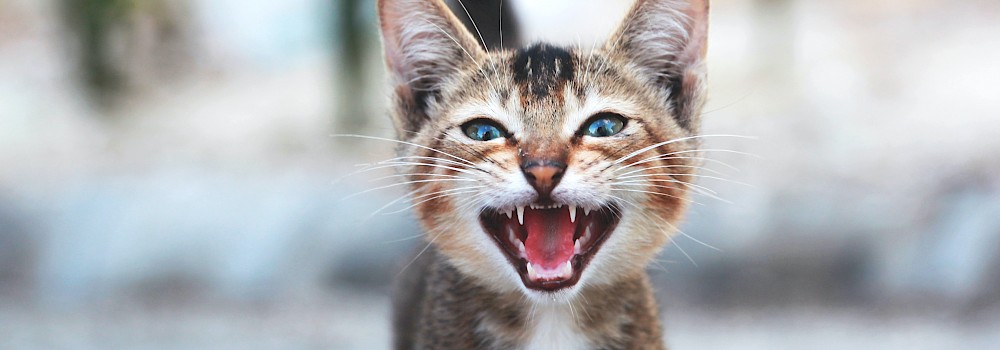How to Spot and Prevent Dental Problems in Your Cat
Dental issues are common amongst felines, but there are ways to avoid this with the right care for your cat.
Added on: 09 Feb, 2023
Posted by: Sandra James
7 min read (1091 words)

Introduction
As it is for us humans, dental hygiene is just as important for cats, yet this part of cat care can easily be overlooked by some cat parents without knowing what to look for. As some cats are experts at hiding their discomfort, it can be difficult to notice if your cat is suffering. If left untreated, dental problems can cause infections, pain and even health issues for the cat, so maintaining your cat's oral health is imperative for their well-being and overall health.
In this article we look into the most common dental issues that cats suffer, and we have gathered the ways you can best care for your feline friend's mouth and the top tips to prevent future dental problems from arising, keeping your kitty healthy and happy!
The Warning Signs
Although, as we know, many cats do not usually display any signs and are good at hiding their pain, there are still some warning signs that can indicate your cat may be suffering from a dental issue.
- Swollen, bleeding, red line visible on gums
- Grey/brown substance on their teeth
- Bad breath
- Pawing at their mouth, drooling
- Decreased appetite, weight loss
- A change in behaviour, grooming themselves less often
If you notice any of the above signs, it is vital to see your veterinarian for a dental checkup. It is also important to monitor your cat's eating habits as this can be a clear indicator of any issues; it is also significant to remember that there can be many reasons cats stop eating. It is best to get them checked out in any case!
Start a Daily Dental Care Routine
The most effective way to prevent dental issues is to brush your cat's teeth regularly. Ideally a dental care routine should be introduced at the kitten stage; you will need to prepare them by getting them used to their teeth being touched from a young age. You should use a toothbrush and toothpaste specially designed for cats, never use human toothpaste on your cat. The high levels of fluoride in human toothpaste can make your cat severely ill if swallowed.

Start by brushing softly and slowly until your cat is comfortable with the whole process. If the kitty isn't a fan of the toothbrush, you can put the toothpaste on your finger, rub it on their teeth and gums, and try to introduce the brush once they are comfortable. Ask your veterinarian to show you how to do this correctly if you are unsure.
If you are going away and leaving your cat with a cat sitter, make sure to inform them of your cat’s dental routine so this can be continued in your absence.
Swap Treats for Dental Friendly Toys and Chews
Providing your cat with dental-friendly toys and chews can also help keep its teeth clean and healthy.
Cats chewing on toys can remove plaque and tartar build-up, and often are available in a fresh mint scent. Check out your local pet shop for dental-friendly toys, or do a quick google search; the chew toy should be hard but not harder than your fingernail as this could cause tooth fractures, ensure to look for toys specially designed for cats.
Specially formulated dental treats can also slow down the development of tartar, so swap out one of their normal treats of the day for a dental one. It is important to remember that dental toys and treats should not be relied upon alone to ensure your cat's oral health - they should be used as part of your regular dental cat care routine.
Provide a Balanced Diet
Though regular teeth cleaning is the ideal way to prevent dental issues in cats, not all cat owners are prepared to physically brush their cat’s teeth. What’s more, not all cats will tolerate the idea, no matter how carefully you approach the issue. Luckily, diet can play a huge role in keeping your cat’s teeth and gums clean and healthy.
Cats who eat only wet food are likely to develop periodontal disease more quickly. This is thought to be because wet food is stickier, so it gets trapped between the teeth and around the gum more easily. This then feeds the bacteria that live there, and they grow and produce more plaque.
In contrast, dry diets are slightly abrasive and may help to reduce the number of bacteria on the surface of cats’ teeth. They may also be less likely to get stuck between cats’ teeth.
Some special dry diets and chews are specifically designed to help keep cats’ teeth clean.
Drinking fresh water helps reduce dental issues as the water rinses away food debris left in your cat's mouth after they eat, so make sure you are always replenishing your cat's water bowl with fresh water.
Avoid feeding your cat sugary treats; while sugar isn't toxic to cats, it can wear away the enamel, leading to tooth decay.

If your cat is prone to dental problems your veterinarian can recommend a diet designed to help reduce the build-up of plaque.
Ensure Regular Checkups
Regular dental checkups with your vet are vital for your cat. Depending on your cat's age this could be annually or twice yearly. Your vet will be able to see the warning signs from an earlier stage, and if there are any indications of gum inflammation, early intervention will result in a successful outcome.
Your vet can also perform a descale and polish for the teeth to remove plaque and tartar above and below the gumline using specialist hand tools. Your cat's teeth will also be polished, making plaque harder to stick to the smooth surface. A descale and polish procedure is carried out under a general anaesthetic and can take from 20 minutes up to 40 minutes.
Conclusion
Implementing these steps can help prevent future dental issues and ensure your cat has good oral health for years to come, keeping them happy and healthy.

Sandra James
Owner & Founder
The Cat Butler was set up by Sandra James in recognition of the fact that a stay in a cattery can be unsettling for many cats and also their owners.
 Cats are happier at home
Cats are happier at home























